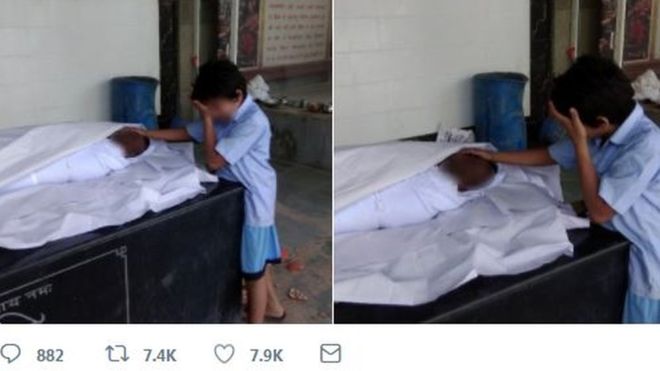A 12-year-old Brazilian boy has allegedly confessed to the shocking killing of a nine-year-old autistic girl, found strangled in wood with signs of sexual abuse.
Raíssa Caparelli went missing last Sunday afternoon from a local charity event, which she was attending with her family, at the Unified Educational Centre (CEU) in Anhanguera, a suburb in São Paulo.
Her body was discovered roughly two-and-a-half miles away from the festival, bound by a rope to a tree in the city’s municipal park.
Investigators said part of a cord was wrapped around her neck but they do not believe she was hanged as her bare feet were ‘flat on the ground’.
Her distraught mother, Rosevânia, told Brazilian Record TV: ‘This tragedy has ripped my heart out.
‘Raíssa was a sweet, docile child. Because of her autism, she was scared and timid and did not relate well to strangers.’
Details released by police indicated that the child was conscious throughout the vicious assault which left her face covered in blood.
Chief superintendent Eduardo Marturano of the São Paulo police department for child crime (DHPP) said: ‘The injuries to her face were so severe it was difficult to even identify her.’
The victim also suffered brutal injuries to her shoulders and deep wounds to her body and legs.
No weapons were found at the crime scene but forensics suspect a piece of wood, possibly a branch from a tree, was used to repeatedly batter the victim, which possibly contributed to her death.
According to investigators, the possible cause of death is asphyxiation. However, a confirmation will only be possible after the Institute of Forensic Medicine (IML) releases its report within the next couple of weeks.
The body has already been examined for sexual abuse as her injuries were found to be similar to the suspected level of violence used, but police have not confirmed this and are waiting for a forensic report to be completed.
Marturano reported additional details of how the victim’s body was found.
He said: ‘A brown male sock was found tied around her left arm together with a blue hairband.’
Security cameras outside Anhanguera Park caught the last moments of the unsuspecting child, who was wearing a pink outfit, crossing a road and walking hand in hand with the accused around 12:30 pm.
In his statement, the suspect claimed he was ‘just walking’ with the victim. They were said to be friends who lived on the same street, played together and studied at the same school.
The body was found around 2 pm on the same day by park security officers who called the police after the youth reportedly alerted them to her location.
He allegedly told wardens he had been taking a short cut through the woods when he ‘spotted a body hanging from a tree’ in an area where access is restricted to park employees.
Bloodstains were found some five-and-a-half yards (500m) from the corpse along with a pair of flip-flops, a small transparent plastic bag and a large red waterproof cape.
Cops revealed that the schoolboy’s mother took him to the police station on Monday after he confessed to committing the crime in front of relatives.
He apparently gave details of how he killed her and claimed he ‘hit her legs and her face, then tied her up while she was still conscious and continued to beat her’.
Police chief Marturano corroborated this statement, adding: ‘We believe the accused started assaulting Raíssa before reaching the tree. First, he hit her and then used a branch. We are still searching for the branch.’
Officers described the suspect as cold without any emotion.
They said: ‘He was restricted with his information only responding to questions by answering ”yes” or ”no”.
However, after confessing to the murder he decided to change his testimony. He claimed a man on a green bike with several tattoos, who he named as ‘Baianinho’, reportedly threatened him with a knife and forced him to help kill the girl.
Police have not ruled out the possibility of an accomplice, because during the attack the victim may have had more strength than a 12-year-old boy, officers said.
The police chief said: ‘Our investigations also continue with the intention of identifying other potential perpetrators of the crime. However, there are many contradictions and inconsistencies in the boy’s statement.
‘He claimed they took a bus to the park after leaving the festival and allegedly told park wardens that he didn’t recognise the body of the girl. Both of which are not true.’
In a statement to police, Rosevânia, said she took her daughter and her younger son to the party at CEU around 12 noon on Sunday. The place was full of children.
At one point, the mother left Raíssa queuing with the boy for a turn on a trampoline while she went to get popcorn with her son.
When she returned, her daughter had disappeared. A hunt was immediately launched by festival organisers and concerned visitors.
The devastated mum said: ‘Over the last few weeks my daughter had become friends with the boy. We live less than a hundred metres away on the same street.
‘She was very close to me and would hardly leave my side, but in recent days she had grown confident enough to play with the [schoolboy] outside.
‘Last month, because he seemed to be encouraging my child to become more sociable, I took him to a church service with her as a treat.’
The victim’s aunt, Rosmari, said: ‘Raíssa had been attending a support centre for her autism for the past year.
‘She was an introvert and she couldn’t communicate well. It was difficult for her to trust people and she was very withdrawn.
‘But when she felt good she spoke. With the educational intervention, her behaviour had begun to improve and she was becoming more trusting and talkative.’
Marturano said he is awaiting a psychological report on the youngster who has apparently refused to give a motive for the crime.
If found guilty, judges will have to determine whether the accused should be hospitalised for a minimum of three years or detained in a youth offenders prison.




